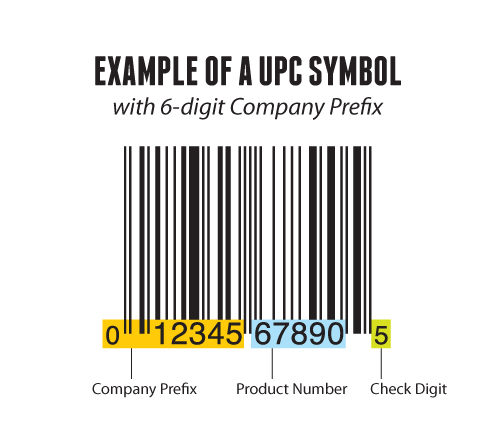 We’re all familiar with them, but do we understand what information they hold, and how to create them? Probably not. We just know that when the cashier scans them, the register beeps and we’ve spent some money.
We’re all familiar with them, but do we understand what information they hold, and how to create them? Probably not. We just know that when the cashier scans them, the register beeps and we’ve spent some money.
We create a lot of retail packaging, and a vital part of that packaging is having a valid UPC symbol. UPC symbols are generated from two bits of information, your company prefix, and the product number. The last number, the check digit, is automatically calculated based on the previous 11 numbers.

Above we can see an example of a UPC symbol with a 6-digit company prefix. The first six digits are assigned by GS1-US (a governing agency for the assignment of manufacturing codes). The next five digits are the product code, which is assigned by the manufacturer. And again, the last digit is a check digit based on a calculation of all of the other numbers (which I won’t go into here, since there are tools that do the math for us).
It’s important to note that you cannot simply create your own company prefix, and resulting UPC symbols, without first obtaining one from GS1-US. This is so you don’t accidentally use a number that already exists, which would really cause problems for retailers.
In a past post, I explained QR codes, which have quickly become popular. These QR codes can be generated by anybody, and do not require any assigning agency or government oversight. In addition to QR codes, there are hundreds of other barcodes that various businesses use internally to help streamline their processes. ITF-14 is a good example. I use ITF-14 as SKU numbers for pallets and multiple-unit cases. These ITF-14 numbers are also assigned by GS1, and are used to encode a Global Trade Item Number.
So, now that we know what these barcodes are, how do we create them? For years, I had been receiving physical artwork for UPC symbols from clients. Obviously this is a pain, requiring that I scan the barcode in, and if you have been reading this blog, that doesn’t provide me with a vector version I so desperately desire.
Recently, I’ve been using a neat little tool I found called the Online Barcode Generator. This no-frills generator is extremely powerful. It allows for the creation of hundreds of different types of barcodes, automatically calculating that check digit, if needed. It provides the resulting barcode in PNG, JPG, and yes, EPS format. I obviously opt for the EPS format. It quickly opens in Illustrator. The barcode lines are strokes, and numbers are actual text (Helvetica), so I quickly outline the strokes and fonts to alleviate any scaling issues.
So, there you have it. Barcodes and how to create them. Go barcode crazy!
This has been today’s Clarified Butter.
